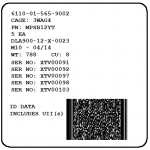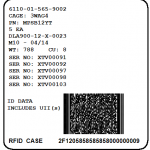Mil-Std-129 Revision R greatly simplified exterior container labels by encouraging the movement of all linear bar code data into the two-dimensional PDF417 symbol. This eliminates up to ten linear bar codes from the exterior container.
The linear barcodes of previous revisions of the Standard may still be used, however, Revision R states a preference for use of the two-dimensional PDF417 symbol. This eliminates a label when more than one serial numbered item is packed, and makes possible the use of automated data collection.
Exterior container markings are required unless specifically exempted in the contract or solicitation, or the standard itself, on each of the following:
- Exterior Container – A container of unit packs and intermediate containers for shipment and storage. [definition]
- Unpacked (loose) items, items that are unencumbered by a tie, wrap or container.
- Palletized Unit Load, a quantity of items, loose or in containers, that arranged on a pallet [definition].
When a palletized unit load of containers or items is formed, the individual containers or unpacked items shall be marked with exterior container identification text marks or unpacked item identification text marks, subject to exceptions noted in 5.3.2.7. [¶5.1.2]
Required Exterior Container Markings
The minimum text information required for exterior container marking are as follows, appearing in the order listed: [¶5.1.2]
- National Stock Number (NSN) or NATO stock number with dashes or spaces and any prefixes or suffixes. If no NSN is assigned, then this line may be omitted.
- CAGE of the Prime Contractor.
- Part Number from the contract or order, if one is cited. Otherwise, the prime contractor part number may be used or part number can be left blank.
- Item description or nomenclature is excluded unless otherwise specified. It is required for hazardous items as specified herein (see 0.d). For protected cargo see 5.4.1.6.
- Quantity and Unit of Issue.
- Contract number or purchase order number with dashes, i.e., DAAB07-96-C-1234. Include the four-digit delivery order number if applicable. Follow contract with Lot Number, if applicable.
- Military preservation method and date of unit preservation or pack date. If a military preservation method doesn’t apply, leave the method space blank. If a preservation date doesn’t apply, use the pack date. Prefix military preservation methods (except ZZ) with the letter M (e.g. “M10” for Method 10).
- Gross weight, rounded up to the nearest pound.
- Proper Shipping Name (PSN) and the North American(NA) or United Nations(UN) Hazmat ID, when applicable (for hazardous items).
- Shelf Life markings, as appropriate. (See ¶5.2.1)
- Serial Number(s), if applicable. If more than five serial numbered items are in the container, use a Serial Number List, and state “SERIAL NUMBER LIST INSIDE” or “UII LIST INSIDE” as appropriate.
Bar Coded Information
Exterior containers require several data elements to be encoded in a machine-readable format, with either a 2D (PDF417) bar code(s) and/or linear (Code 39) bar codes [¶5.4],[¶5.4.1.2].
- NSN, contract/order number, CAGE, CLIN and shipment number.
- Serial Number(s). If more than five serial numbered items are in the container, use a Serial Number List instead of bar coding each on the label.
- Unique Item Identifier(s), encoded in a 2D PDF417 bar code. If more than five UID items are in the container, use a UII List instead of including each in the PDF417 on the label.
The use of a 2D PDF417 symbol for unit and intermediate containers is optional, required only if the item(s) are UID. The standard [5.4.1.1.1] allows for the use of linear and/or 2D symbols.
RFID Information
RFID tags do not have incorporated into the identification or shipping labels, nor does the RFID need to be printed anywhere. However, it makes sense to do both to simplify handling and data collection during printing.
The exterior container label is a logical choice for RFID-tagging. Because the CLIN, quantity and UIIs in the container (if any) are known at label print time, it is simple to collect this data for submission to Wide-Area Workflow(WAWF).
It is not required to print the RF tag ID and container level, but doing so simplifies preparations for shipping. If these are printed on the label they should appear below the identification information required by the standard.



